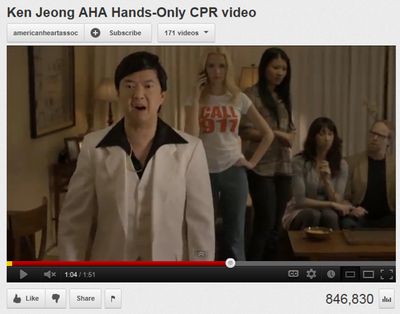Keeping the beat
Web videos, mobile app offer quick, easy lessons on simplified CPR

Learning CPR isn’t what it used to be. For one thing, “hands-only” CPR requires fewer steps – no pulse check or mouth-to-mouth required – which safety officials hope will lead more people to perform it.
Also, these days, “Stayin’ Alive,” the Bee Gees’ disco anthem, keeps coming up. Its beat – “Well, you can tell by the way I use my walk,” and so on – matches the 100 chest compressions a minute required during resuscitation efforts. Keep that worm in your ear, safety advocates say, and you’ll be on track to simulate a cardiac arrest victim’s heartbeat.
Finally, now you can learn hands-only CPR on your phone – via a new app from the Red Cross – or through online videos. Those user-friendly efforts are part of a broad campaign to teach bystanders how to keep victims of sudden cardiac arrest alive until EMTs and paramedics arrive.
The efforts are making a difference, said Assistant Chief Brian Schaeffer, of the Spokane Fire Department. He gives partial credit to hands-only CPR for a recent increase in heart-attack victims’ survival rate in Spokane.
In 2011, the Spokane Fire Department saw a 44 percent survival rate among heart-attack victims treated by its emergency personnel. That was up from rates ranging from 7 percent to 14 percent in the past few years, he said.
The life-saving technique requires no long classes, no fees or certification, and no mouth-to-mannequin sessions, Schaeffer said.
“It makes it so simple for somebody to be a hero,” he said.
The American Heart Association has changed its CPR guidelines in recent years, in 2008 telling bystanders untrained in traditional CPR – or unwilling to do it because of fears they’d catch a disease from the victim – they could do hands-only CPR until paramedics arrived. In 2010, the association said even those with professional training should do the compressions first, before opening the victim’s airway and breathing into their mouth.
The latter change closely followed publication of a large study by the Journal of the American Medical Association that found that more adults survived heart attacks when they received continuous chest compressions to mimic a heartbeat, compared with traditional CPR.
Traditional CPR, which combines mouth-to-mouth breathing and chest compressions, is still best for infants and children, drowning victims, or people who collapse because of breathing problems, according to the Red Cross.
And CPR that includes rescue breaths produces better neurologic outcomes for cardiac-arrest victims, said Stacey Bogar, a CPR instructor at the American Red Cross’ Inland Northwest chapter. But hands-only CPR lets bystanders keep oxygenated blood moving to the victim’s brain, which is a lot better than doing nothing.
“That means somebody’s not brain-dead,” Bogar said.
On the eve of Independence Day, with its slate of family gatherings and physical activities, consider these resources:
• The Red Cross’ first-aid app, free for Android and iPhone users, was launched this month.
“It only takes a couple seconds to bring that up, and if you don’t know CPR it tells you how to do it,” said Sam McQueen, a disaster preparedness specialist at the Red Cross’ Spokane office.
A 28-second video tops concise written instructions for checking the victim’s breathing, calling 911 and performing chest compressions.
• A longer video produced by the Spokane Fire Department shows viewers how to perform hands-only CPR and explains how and why it works.
In the video, the department’s medical director, Dr. Scott Edminster, explains how compressions keep blood flowing to the victim’s heart and brain until professionals arrive and use a defibrillator on the patient, sending electricity to the heart to restart it.
Only about 10 percent of people will survive a heart attack if they get shocked after 8 minutes, Edminster says. “But if good chest compressions are started right away, when the person goes down, you can alter that ‘death curve’ … People will respond to electricity quite a bit longer.”
If CPR is started immediately, he says, the survival rate for defibrillated patients rises to 40 percent or 50 percent.
• A wide-lapelled Ken Jeong, the comedian known for his roles in “The Hangover” and NBC’s “Community,” stars in a video produced by the American Heart Association that emphasizes the 100-beats-a-minute aspect.
“Disco can save lives. Yes, disco,” he says.